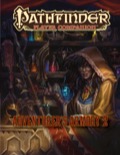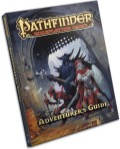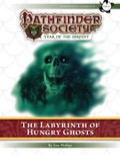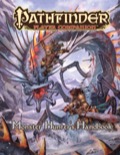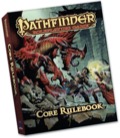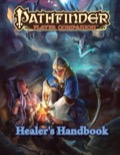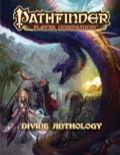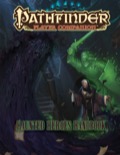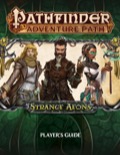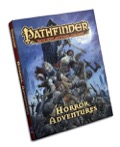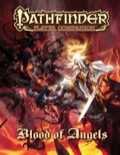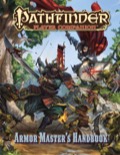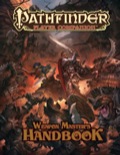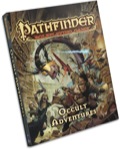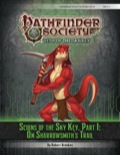Sign in to create or edit a product review. What the hell Paizo. . .If you where looking for an Adventure's Armory part 2, THIS IS NOT THE BOOKM FOR YOU. Well, to be honest, I guess to be fair, it depends a lot on just what you liked about Adventure's Armor (or Ultimate Equipment). It you liked crap like Item tricks, a lot of less than useful gear to take up space, and niche options that are generally too costly to use, this is the book for you. If you like the best options simply being reprints from prior books, INCLUDING Adventure's Armory 1, this is the book for you. All in all, I really found this book a step below "meh". None of the spells or traits stood out at all. The single item I'd actually really consider buying is the Spring-Loaded Scroll case, and that is only because Paizo's answer to the Spring-Loaded Wrist Sheath question for years in regards to scrolls has been silence. Gone are the days when we get some essential adventuring gear like the Masterwork Backpack, but now we get extremely niche gear and a bunch of overpriced options for improvised stuff. (Isn't that sort of the opposite of what we should see in Adventure's Armory???). We really need a Zero Stars options, because I really do not recommend this book. I realize this review will probably be deleted or I might be banned, but yes, it's really that bad. Overall, not a bad book. As mentioned, it does have a lot of reprinted material, and while it's nice that this means one has to look through less books to find some things, it also means that there is a lot less new stuff here. Between the two, I'd much rather have more new things, such as a Spellcasting option for the Eagle Knights faction. I'm also iffy on why some organizations where included here, or at least in detail. With Path of the Hellknight being a thing, why not devote some material to the Rift Wardens in this book instead? I'm not really sure why the Silver Ravens are in this book, (for multiple reasons, really), but it is lacking mention of Lastwall and Mendev Crusaders. Or the Concordance of Elements, for instance. The book is similar in many ways to The Inner Sea World Guide and Inner Sea Gods, but probably not as useful at the table all around, more because of the nature of the material than the writing. If you pick an area, or even a general region to set a campaign in, roughly 75% of this book will probably not apply, or might show up once. Again, just the nature of the book's material, although there are also plenty of options for players that may still be useful, and perhaps not as limited to location. I don't believe the spells for instance are as strictly bound to a given organization or region. An Al-Zabriti Cleric/desert priest or even dervish would have been awesome. A few things I'd have liked to have been included:
I just finished running two tables of this online, and part of me wants to give this one 4 Stars because it really does have an interesting story and there are many elements to it I really enjoyed. But, at the same time, there are many things that make me want to give it 1 Star as well. In both games, I didn't really have a single character that was really ready for this scenario, which in itself is fine, but it did make a lot of things very difficult for the parties to progress or actually learn what was going on. Add to that that a great deal of the lore and general information is rather spread out, both tables complained of not really understanding what was going on throughout, (which to a degree was intentional). I did have to go through a lot of extra effort at the end to explain things, though, which was partially to so many failed checks, and partially because there are so many small hints that are easy to miss or forget. As a DM, a few things about this one I absolutely detest:
The final boss is basically designed to say "Gotcha" to players that are supposed to be good at certain things, for the sake of making that antagonist be cool or something. This is terrible writing, in my opinion. Especially at this level range, Character's abilities, tricks, and tactics should not be arbitrarily removed or negated just so a story can play out the way the author wants it to. Good adventure design allows and encourages those abilities to work, not removes them from play so that their pet NPC can do stuff. One of the Boons at the end is very unclear as to how it actually works. It says that Characters receive one, and then says you have to buy it. Which is it. Do you get one for free, and then have to buy additional uses thereafter? While I did enjoy the overall theme and mood here, one thing I was a bit disappointed with was that there was not really a great deal of variety in encounters, and in one of my groups, we ran into an issue with how to handle an Alchemist vs so many Incorporeal enemies. A strict reading of the rules would have left that player sitting on the sidelines wasting all of his bombs repeatedly, and while not something directly the fault of this scenario, it is something that came up often and should be looked at. Without going through the major Haunt in depth, (and to be honest, the rules are written more as guidelines anyway which sort of makes that impossible), I'm pretty certain that the Haunt's rules are all jacked up, and the CR about 10+ too low for it's area. It was a bit funny, as on one game, both of my Monk's are the only two that made the initial save, and their first tactic to "help" the rest of the party was to attempt to Grapple them. <FACEPALM> In the end, there is a lot of good here, but there is also a lot of bad here. The story itself is rather straight forward, but also very cool, but is really hindered by how little of it the party might actually find out, and the "gotcha" style that seems like the author was writing this to be very DM vs Player really hurt this one a lot. It was fun, but will most likely be remembered for the amount of frustration it brings in play. Outside of the original Bestiary, I'd say this is my favorite monster book thus far. It didn't follow any particular theme (outside of generally higher level), and seems to have a pretty good balance of different creature types. I really love the Rougarou, my new favorite 0 HD playable race besides Aasimar. And while I may or may not ever use them, I enjoyed having some deity-level stats presented. A touch more for lower CR baddies would have been ideal, but still, I like this one more than prior Bestiaries. A lot of the other reviews make a lot of very good points. After reading through it, I do like the number of mechanical options presented, although I do find many of them a bit on the weak side, not particularly useful in many cases, or too specific. The end result being that I'm probably not going to actually using much, if any the material, but it was not outright bad or terrible either. I think my biggest complaint is just how little the different classes, or even general builds actually get here, and that there is just far too much to that could be done, that this book does really even scratch the surface on the subject matter, especially in areas like for fighting Undead or Dragons, that while they have their own books, they likewise just where not enough. Spells where pretty standard for what you would expect. Same with gear. Nothing really jumped out as particularly genius or cool, but likewise was not "meh" or insulting either. I was disappointed how little there was for a "Fey Hunter", really of any build or concept. There is a Bard and a Druid archetype, but that's basically it. Outsider Hunters likewise just felt like it wasn't really touched on much, although the Paladin Archetype looks amazing. The fluff and flavor was readable, but honestly I have very little interest in that aspect of the books, and it, like everything else was just far too little in what it brings to the setting/game considering the focus. However, as a Pathfinder Player's Guide product, it could have been a lot, lot worse. All in all, it's a nice little item for a quick afternoon read, but not one I would say is essential to play. I really like the product. While not really a "pocket"-sized edition, I rather like the size of the product, and would be absolutely interested in buying more like this. <Purse edition perhaps? :P> The book is very readable in it's size, if not ideal (in my opinion). The book does feel easier to flip through than the larger hardcover, though not by much, though it will also be much harder to tab pages for easy reference as the cover is the same size as the rest of the pages, offering no protection around the sides. Not a huge deal, though. Aside from the Fan Boy/Girl factor, . . .I really don't understand why this book got such good reviews. I was very hesitant to buy this one from the start. Both because past experiences with cramming in far too many things into one book have led to, well predictable results and the very, very thin theme of the focus here. This is probably the first product I outright want my monies back. But probably worst of all is that this book probably kills any possibility that the few races involved here I actually do want a Player's Guide for are likely to never get a good one now. It's pretty much as I feared, far, far, far too little on anything I'm interested in, except I'm struggling to actually find a single thing I find interesting, good, or something I'd use. Just too forced, and the actual goal seems to be to make sure a few snowflake things get in the game rather than focusing on each of the races, and it shows which of the race options where favored and which got options because they had to get something. A book on healing is going to be a very daunting task, so it's hard to judge too harshly here. I'm not terribly impressed with this book, but I'm not angry I purchased it either. In general, I found the majority of the Archetypes very lacking, especially the Angelfire Apostle I was most excited about. I'm also a bit disappointed that the book starts out describing how the ability to heal (including removing conditions and raising the dead) is the most miraculous and wondrous feat of all magic, but then the book basically goes out of it's way to hand it out like candy. I'm of the opinion that there is already too much available, cheap healing as is, and it's detrimental to the game, so adding even more, and basically stomping even more over the line of one of the defining traits of divine magic (vs Arcane, Occult, and Martial abilities) was a really poor call. Again, just my opinion. It lacked much in the way of non-magical applications (or expansions) for the Heal Skill, or even much in the way of talking about healing equipment or goods. Unfortunately, I just found most the material bland and/or mediocre. On one hand, I love just how much crunch they put in this book, and am honestly surprised with how much they touched on so much variety, (a trait for this deity, an option for that one), I didn't really expect to see. I also like some of the spells the book offers, but at the same time, I really wish they where a few Spell Levels lower so that they might actually be used in play. Or at least had lesser versions. I think there was just far too much split focus for this product to really have been that effective. No real Channel Energy or Lay On Hands options, and as I mentioned, nothing really for the Heal Skill. There is a bit for Occult stuff, but even being not a fan it looked kind of lackluster. For the most part, this book doesn't really make Being the Healer Fun as it offers a few different ways to do so, without really helping to much to do it well or that interestingly. It just doesn't live up to the Arcane Anthology. From premise to fluff to crunch I think that the authors just really missed the point. Almost the entire book revolves around what to me feels like a very lackluster in-setting manual with a heavy snowflaky sort of backstory. I didn't really check, but I'm pretty sure that the setting material used here is mainly something just made up rather than using existing material. I was hoping more for either A.) some sort of Divine/religious themed artifacts or tomes or B.) maybe something like the religious teachings of the Godclaw, combining a few deity's tenets together. I don't know, I was hoping for a Divine version of Arcane Anthology, and this is nothing like it. While it does have some good stuff in it, I also feel like there is way too much that should have been put in other books, like the Paladin Codes, especially when the Patron's are not even otherwise touched on in any meaningful way. Perhaps I had my hopes up too much, but this one just doesn't really do much for me. Having run this twice, I'm really not impressed with this. There was next to no challenge throughout, and really minimal effort to really allow the different character to really show off their uniqueness. That was really the one big thing this one had going for it, but it sort of feels like all efforts where made to make sure everything was just sort of normal or trivial. The story was ok, and has the chance to be epic, if PFS Golarion deviates significantly from normal Golarion's year zero concept, but I also have a strong feeling that the potential setting evolutions implied here will simply go nowhere instead. The mechanics where very clunky throughout, and while I really miss the old school Faction Missions and handouts, it just was not handled here at all, serving to remind us how cool it used to be and then not delivering. So far, Season 8 has been a lot more miss than hit from what I've read and run, but I'd rank this as the least interesting scenario of the lot. It also felt like a really poor choice to leave the characters nearly completely in the dark from the beginning in regards to their own affiliations, when this could have been a good opportunity to introduce a new organization or even possible Faction and have the Players discover things as their characters do. I didn't care for the book, but it's really hard to place a finger on just why. Part of it is I just didn't think it did a great job of including options for a lot of classes to take on Horror or Haunted elements. Some, like Spirit Ally sound really cool, but become available so late game it's questionably even worth it, just to get a sort of limited version of a Spirit pet/Haunted Curse without having to take or dip those classes. If this would have been a level 1 option that upgraded or grew stronger, this would have been amazing. But having to wait until 8th level just makes it feel like a wasted potential option. I didn't care for the Haunt Spells, partially because they seem to be there to both steal a lot of the character's that focus on or are strong against Haunts thunder or just seem very odd mechanically. Part of this might be related to my disappointment with both Horror Adventures (lack of player material and poor mechanics like Sanity) and also Occult Adventures awkwardly cramming in themes and mechanics that just don't work well in the preexisting setting and material, and Haunted Heroes sort of ramps that up. While Haunted Heroes does offer a lot of Archetypes, it just felt like they ignored some of the classes that actually needed them for ones that didn't. I also found the religions chosen, (and the options given to them specifically) very curious. So many of them seemed out of place, and then the unique options to replace a given Domain power, while cool, also felt like a huge missed opportunity to make those things options that other's could take and make a lot more sense in doing so. For instance, Irori followers get a supeup Channel to Harm Undead Haunts ability, but Iomedae, Sarenrae, and even Pharasma don't (despite it actually making sense for them to and Irori not). The Possessed Hand chain is very interesting and fun, and generally open to everyone, but it's also very odd. Does Channel Energy/Alignment Channel kill it permanently? Spirit Ridden and Channel Spirit I think would have been much better off as, similar to Spirit Ally, (or even better upgrades for Spirit Ally) options for all characters to be able to dip into getting a spirit-like pet, but instead it is kind of a lackluster séance thing that realistically takes a character 3 hours per day to prep between spells (if a spellcaster) and then an hour long séance for each. This was not really a good book for all the lacking player content from Horror Heroes, but instead seems to follow in the same footsteps in a lot of ways. There are some good options in here, but in my opinion too much of it is arbitrarily limited to make sure only some classes take options or that the flavor, it's stronger point is not really that supported by it's crunch. I liked the art overall, and particularly LOVED that it didn't focus on the annoying icons often. Honestly, I wasn't very impressed with this one. Reading through it, I think I actually lost interest in the AP instead of building towards it. It felt too much like product placement for the Occult Adventures material instead of focusing in on Lovecraftian or Horror concepts, and a great deal of the advice comes down to trust us and trust your DM, which would have been better, I think as a discussion aimed at the DM in the product itself, and how to talk to their groups up front, rather than a plea towards the potential players. It offers a heck of a lot of suggested options, but very little reason why they are good, how they will matter, or ways to really help other than just a name. It also seems to ignore, (maybe they forgot they existed) others which one would imagine would be really good fits. Too many suggestions also make it very meaningless. Reading through it, it also really seems that whoever wrote the guide also has little idea of what is coming, and the later sections and mechanics/options seem to strongly disagree with a lot of the flavor and mood that early sections suggest, (or at least implied). All in all, this was a very weak guide that seems to miss the mark. And while (not a complaint directly about the guide itself) it's cool we are finally going back to Ustalav, we are also told up front not to expect to stay there long, and again seems to strongly imply the goal is to focus on Occult Adventures aspects rather than Horror Adventures. For the most part, I liked this product, though I do have a few concerns. I was a little disappointed that so much of the material presented is for the DM only. There is some stuff for the Players, and plenty that Players could use if they wanted to, but it's clearly there for the DM's to use against them. One of the main issues overall is that this book, designed for running horror games or introducing horror elements into gaming just doesn't stand out from other products from other systems well. For DM's that do have other experience and products to draw from, there just isn't much here that is needed or that they couldn't do themselves with relative ease, or just port in. However, for DM's that don't have much experience with horror games, I could see this being a decent intro guide. Not so much for players though. Primarily that there just are not a lot of options for Players to fight against "horror" monsters or encounters, and in particular one would think that there would be plenty in here for Clerics and Paladins. Unlike many other hard cover products that introduce a new system or theme of play, this one is pretty lacking on ways and methods to incorporate the basic game into the style of play, except for some very basic RP suggestions, (what is your character afraid of?). I was also pretty disappointed that so much Occult Adventures material was included here, especially when there really isn't a great deal of crossover themes between the two products and Occult Adventures was already kind of poor at doing it's own thing or being very inclusive of much of the core material itself. It really felt like Paizo couldn't get a lot of the Occult Adventure's stuff finished on time for that product and so sort of inserted it here, except a good deal of it arbitrarily has "psychic" prereqs, meaning only some of the Occult Classes can take those options, which is stupid. I also found it kind of annoying that there was little for the CRB classes, but also just gear in general, magical or otherwise was pretty uninteresting. All in all, these things just make the book feel very incomplete, which is a trend I see being repeated in Pathfinders Hardcovers since the ACG was rushed out. I wasn't terribly impressed with the Insanity Damage concept, and I don't really see how looks, power of persuasion, or book learning relate to your sanity or resistance to loosing it. I thinking going off of Con would have been a better idea than Int or Cha, and the system is just odd, because really, even in the book, it seems the only attacks that relate to insanity deal Wis damage, (or as an alternative Sanity Score Damage). I'm not a fan of either implementation or the intention here. It really felt like someone had a pet peeve that their high Cha or high Int character didn't want to worry about Wis, (or maybe to show that high Cha characters are more sane?), and tried to force the system to work around that, but it doesn't actually seem to work. Why wouldn't a high Int and/or high Cha be a NEGATIVE insanity modifier. The book kind of comes in as a combination of 3.5's Book of Vile Darkness and the more DM focused sections of Heroes of Horror and Ravenloft, (the later two I'm extremely bias towards, so that is certainly boosting this books star rating, maybe more than it deserves). The main problem though, as that it really takes a bit more from the former, which was, well, not so great. The later two are some of my favorite d20 based books out there, but I think this could have used an injection of player options to make it glorious rather than good. As a Player Book, this one is a 1/5, though as a DM book, a solid 3/5. The lack of much for Players, the majority of the population just really hurts this book a lot, and honestly, I think that it would have been better to focus on the Player's side for this book, and break tradition to make the normal Player's Guide that follows (Haunted Heroes in this case) the DM focus book for this case. Especially as it would have done a lot to keep the DM tricks and tactics concepts out of the Player's hands in general. I'm just going to go ahead and say it. I hated Occult Adventures, on it's own merits. It felt forced, unready, and didn't mesh at all with Golarion, much less generic fantasy in the same way that non-transparency Psionics didn't. A lot of the issue was how little interesting material, or how incomplete that book was for it's own new classes. Horror Adventures was mainly a hugely missed opportunity in that it seems Paizo tried so hard to fill the gaps from Occult Adventures by putting them in here, except for, well it doesn't work. Too little, too late, and too not for players. EDIT: Honestly , this is probably my 4th or so edit of this review, and the more I read it, the more the stars just keep dropping (4 to 1 at this point). I want this to be better. I really, really do. But after further reading, giving things little time to sink in, and reexamining it, (and this is including with Strange Aeons), this book just doesn't hold up. For either Players or DM's. It's doubtful, but hopefully Paizo will take this all into consideration, and just redo the book. It's very hyped up, but just doesn't deliver. You CAN do so much better. Highly Recommend and I want MOREBetween this, the Champions of Purity, and Faiths of Purity, I am highly impressed. These three really stand out in the Player's Companion line. It's very refreshing to have Player Material focused on the Good Alignments, though, not really being exclusively a book about Good, much of the content here is more orientated towards Good than Evil. Personally, I'm not a fan of Tieflings, so I'm a bit bias towards Blood of Fiends in general, but this one, in my opinion, blows it and all of the other "Blood of" books out of the water, (up to and including Blood of Shadow currently). It's a fun read, with some solid crunch too. The alternative Heritages are a bit on the strong side, for lower level play only, but still interesting and cool. This, along with the two above mentioned books are the standard for Player's Companions that Pathfinder should aim for. And in particular, albeit far too late not, this is also the minimum standard that all the "Blood of" serious SHOULD have aimed for. I tend to agree with both Rapanuii's and Kitsune YMG's reviews. It seems to offer a lot of options on the surface, but the more you look into them, the worse (or very circumstantial) they seem to be. In a lot of ways the book also seems like it was not well thought out before going to print. Unless I'm missing it hidden somewhere not at all obvious, the biggest offender kind of across the board is not considering how Mithral alters the Armor's type (light medium, or heavy), and it's unclear, either RAW or RAI if, for instance Mithral Full Plate would allow someone to use Medium Armor options, Heavy Armor options, or both. Many of the Style Feats specify Proficiency in an armor type to qualify, but not to actually use the Styles, which is also sort of odd, leaving me wondering if that was intentional or simply something that wasn't considered or left out by accident. Too much potential for table variation for me to consider using until clarified or the book gets errata. I felt there should have been a lot more emphasis on Heavy and Medium Armor and a lot less on Light Armor or Bucklers, which would have fit better in places like Heroes of the Streets or Dirty Tricks Handbook, for instance. At the same time, it really seems that too many options, for instance the different magical armor/shield abilities are arbitrarily divided between categories. For instance, why is the Balanced property, (picked at random), a Medium Armor only magical ability? Something I am also seeing, but have not really went through other books to confirm, is that there does seem to be a lot of names reused, (but not to update previous material, but rather as a new item/feat/etc. . . that does something totally different). Like for instance, ironically, Balancing Armor. In the end, there are a few (potentially) nice options in there, but a great deal more less than great ones too. It does seem very similar to the Weapon Master's Handbook, and if you where in love with that book, you will likely be moderately please with this one as well. It is very focused on the Fighter just like the Weapon Master's Handbook was, and similarly tends to focus a lot more than I feel it should on uncommonly used items rather than doing much for the ones that do tend to get used much more frequently. YMMV When I think of armored characters, I generally see Cavalier, Cleric, Fighter, Paladin, Samurai, and Warpriest at the top of the list. This book is certainly geared towards the Fighter above and beyond anyone else, and some of these classes do get a little love, the book just really doesn't seem all that geared towards them that much. Not in the way it seems it should be. This scenario is very confusing, both to the players who simply have no real opportunity to learn what's actually going on, and no real motivation to care, but also for the DM. Information is scarce (possibly explained in part 2), and extremely poorly organized. Everyone walked away very unfulfilled after play. The direct ties to Occult Adventures just outright failed, and hurt the scenario as there is already far too much going on, trying to push in the new material (that really doesn't fit at all) and really has no tangible point was just a bad idea. There was far too much forced RP and railroading going on, essentially the story happening with the characters as observers or interacting with one-dimensional NPCs that share way too much personal information for no apparent reason and in an unrealistic time frame. Lost Legacy wrote: This bone-white candle has the power to transmit occult information across great distances. To form the necessary bond, a group of between two and four creatures must participate in a 1-hour occult ritual that culminates with lighting the candle. So, assuming that Bakten is one of those 4, what happens when there are more than 3 characters playing? They just left out? Did the writer even bother? Doesn't really live up to the nameWhile it is filled with a lot of stuff, a lot of it is fairly underwhelming, far too specific, and tends to be either another way to do something or not terribly great. This really SHOULD NOT have been a setting specific book, but then really, most Players Companions shouldn't either. A lot of the options here seem to be designed with the "Okay, build an new character to use these" than "Oh awesome, here are some cool things you might be able to take next level". Far too much is Class Specific, something that should be avoided as much as possible, not continued. Not really sure what else to say. Great idea, but my opinion is was not handled well on too many fronts. Not enough variation or options for most of the different groups within the book. Mostly too little of this and that and than too. Take away is if you really loved the Melee and Ranged Toolbox books, you will probably love this one. If you felt let down with those two, this one will be basically the same. A lot of often requested styles are not touched upon, or much/in a practical way, while others are done yet again. Player Review I'm not entirely sure how I feel about this one. I find Fey kind of "meh", so the fact that it seemed built around highlighting the Fey was likewise "Meh". I generally consider it bad writing when the NPC's seem to be there to out-spotlight the players, but I'm not sure just how true that is in the scenario as a whole, as I haven't run it. The puzzle was, how do I say this,. . . a clusterf!*%. I really didn't care for the encounters much. Not particularly interesting, but very frustrating for the layers (not characters), which is kind of true for the scenario as a whole. It's ok, but for the players it's mostly frustrating. I'd say the big bag was the one sort of interesting stand out, but it just didn't last long enough to be as cool as I (we?) had expected. We had to be pushed a lot to try out the portals, and so I finally caved for the DM's sake, and every single time rolled poorly, showing it was just a poor idea, (sort of like casting a sleep spell on yourself and willingly failing the save so you can sit there while others do stuff and rounds tick by). Yah, that was fun. I think the major issue, though, was just how lacking the scenario was on basically anything about the town/area at all. Or, you know, all the information that a player might ask that would be pretty pertinent to the scenario. Like what are First World Fey Circles, and why do I care? How are they significant, and then out of nowhere, they become significant, but not explained at all. It's kind of worth it for a fairly meaningless romp, (diplomacy or attack rolls, whatever), for a fairly cool Chronicle Sheet, but not terribly memorable besides a lot of frustration. I do recall our DM commenting on how surprised he was that the entire party kept pushing to know what the deal was between the two mayors and wanting to try and deal with that, but basically had to tell us out of character that that was outside the scenario. I guess this one wasn't playtested too much, as the obvious things just where not included or even avoided. I wasn't really planning on buying the book from the start, and really only broke down because I know it's going to start coming up in PFS. All in all, (still reading through it myself), I'd have to agree mostly with Marco Massoudi's review. So, be warned, a bit bias, and I am not at all a Paizo fanboy/girl. I think my main issue with it is just how misleading "Occult" is, and how little the scope of this product really is. Being just how much emphasis is placed on spirits and ghosts, undead, faith and philosophy, the Planes, and the like, you would think that this book would have a lot of crossover with the existing divine, (or even Arcane), classes that share a lot of thematic space, but instead, the vast majority of the book seems to focus more on making a third, unique snowflake approach that shoves itself into a design space that really didn't need filled before hand. That is, by basically shoving other similarly themed classes over to make room. Lacking the bestiary section really undercuts the products usefulness and really comes off as a money-grab. I's also disappointing just how little it seems to focus on playing "occult" games outside of the new classes, and offers rather little for everyone else. It's not so much that the product description lied or was incorrect as that it could have done a lot better a job on some aspects than it did. It was posted a few times that the product would also be introducing a lot of ways to include horror/occult/mysteries into you game, which again, not technically a lie, but it was insinuated it would be to a higher and more broad degree than it seems to have. I guess we will need a new book for that, too. In particular, I found the gear section very lackluster, and well, just lacking. Kind of felt like it was some sort of Easter Egg or April Fool's Day joke rather than something that one would find inside of a purchased product. Even a lot of the more unique rules and new flavor aspects just seemed, I don't know, lacking. In the end, I think that how useful and likable you find the book really depends on just how much you are interested in playing a Kenetecist or the other classes presented in this book. It doesn't do much (that isn't already done) for anyone else or DM's just wanting to run a themed game outside of the book. So, for example, while Mythic Adventures offered material for everyone and new It was difficult to pin a number on this one, as it really, really just depends on how much you like the new classes. If you wanted more options for non-"occult" characters, it's really not for you (0-1 star). If you love the concept of "psychic" "magic", it's probably a 4-5 star book. It is NOT (3E) Psionics, though there are some minor thematic similarities. However, it is also not, for good or for ill, the ACG. I went with 2 rather than 3 though as while the book is good for it's pretty niche purposes, it's a Adventures style book I hope is not repeated, hoping the next themed book focuses on all the other classes, play styles, and the like over some new classes pretty much exclusively. I was extremely skeptical about making the purchase to begin with, and really only broke down because I knew that's I would be forced to make PFS rulings on it, and because I was lead to believe it would offer a lot more thematic elements all around for play and play styles. It did, but only in a certain manner of speaking. I think my biggest gripe with this book is that it seemed to take all of the poor implementation from D&D Psionics and repeat them. For example, making a bunch of "Psionic Only" rules that really have no purpose other than to enforce an unneeded niche. Or that Occult Magic functions similar but different than non-Occult Magic, and a simple 2,000GP Ring effectively grants the equivalent of a free Still Spell (in addition to being a cheap and great item itself), Ring of the Sublime. Outside of cases like the PFS example, I wouldn't really say it's required reading unless yourself or one of your players just really wants to play one of the new classes, (perfectly understandable). It just does not offer too much beyond that, likely unless you buy a few more books down the road. Revisiting this review, I'd really have to say that I place this book at the absolute bottom of the pile. While some of the classes, and I do mean some, are interesting, I really see no need whatsoever for them to have been full classes, which, in the true Paizo way, just robs other classes from having these cool options as these new ones push everyone else aside to stake their claim. I'd much, much rather have seen a Cleric or Witch with a ghostly companion, the Wizard focus on unlocking powers of the mind, options for all casters to be elementalist themed "kineticist", and on and on. By locking these themes and concepts down to a certain few classes, I'd honestly just rather the book didn't even exist. Pathfinder/Golarion already had a lot of potential that "occult" material could have been amazing, but instead they decided to make it a brand new broken as hell option, much like 3E Psionics was, and then cram it into a lot of the prior lore and mystery obtusely. I just finished this for the low tier and am getting close to finishing for the high tier PbPs I'm running, and it's pretty clear the high tier game is both much more challenging and fun. The low tier group basically waltzed through everything except the final encounter (and I even lumped the last two waves together for time and well to make it interesting). Focusing on just the low tier game for now, as I have not fully finished the high tier. . . ON the DM side of the screen, I felt that a lot of the mechanics to sort of ramp up the threat, both social and environmental hazards where too complex for what could instead have been a much simpler way of handling it, and the extra room could have been better used filling in some of the gaps and unexplained backstory. It's not that they are too bad or too complex, just why work harder instead of smarter? I think the Challenges with the Praetor could have worked a lot better, essentially boiling down to "Ok, now show me you can flex your muscles", "Ok, now show me you can open a book", "good job, I think you will survive out in the bush". I do also feel there was a missed opportunity here for Liberty's Edge and the captured slaves, but pretty minor. I was, however, extremely irked for my low tier players that the special Haversack reward was not open to them. It makes a nice little "trophy" item, and as someone that likes to collect these sorts of special items myself, it just rubbed me the wrong way that it's high tier only, particularly as it's probably the lower level character that would be most interested in purchasing it. It's already a pretty cheap item, so the special Glyph of the Open Road version should really be open to all. One thing I also noticed, and this might just be a bit more evident due to PbP, is that after the 1st combat, but not including the waves in the final encounter, it really felt like it from one combat to the next to the next to the next with no actual break in between. In the sense that "Ok, you kill the ____ and have a short rest, healing up, and as you get back on the path to travel to your destination, roll Init. Ok, wew, take a minute to catch a breath and pass the wand around, oh, just as you finish that drink of your waterskin, . . . wait, what's that in the trees? Roll Init." Might have been more interesting to have the bridge encounter happen before reaching Fort Bendu, maybe even within sight of some of the soldiers who then have a possible reason to suspect they are, oh gosh, dirty Pathfinders. While I like combat, I think evening it out a bit more would have been the better option, and I'll probably make that little change if I run it again. Right now, I'm going with 2/5 stars, just based on the Low Tier play through. Once my High Tier game is finished and I discuss it with the players, I'll come edit this and adjust it. Reading though, a lot of the material just seems out of place. Maybe not out of place as much as maybe they couldn't find a more fitting book to stick it in? A new Druid archtype that's exactly what everyone needed <sarcasm>, a new way for Druids to stand head and shoulders over just about everyone else, but literally and steal the reach Cleric's thunder. A Fighter stepping on the Barbarian's toes. A two-page spread showing the OGL giants kind of like the 3.0 size categories. I'd almost say this might be the Giantslayer PG, but nope, that takes up the last few pages of the book (again!!!). Not sure what the deal is with the weapons? Are they reintroducing the old school weapons deal less damage against larger creatures rules? Printing error? I don't know, too much of this book just screams, well, something other than "giants/vs giants". Two things did stand out though which where kind of cool. Skill tricks (and unlike that god-awful Tech Guide, doesn't require a Feat to be able to use what you already have), and they are not terrible either, and then there is the Rogue Archtype, which is just cool, (and I don't even like Rogues). Yai-Mimic Metamagic has some potential (drop the setting flavor). Very Salubri. :) SPOILERS OBVIOUSLY FOLLOW Really enjoyed running this one. My only complaint is that there seem to be some glaring sort of facepalm moments that the writer either didn't consider or didn't care about involving certain alignments, classes, and setting faiths and both the entire premise of the mission as well as the railroaded way the scenario plays. Spoiler: It seems very hard coded in that some classes just are meant to either receive a failed Chronicle sheet from the start, ignore their class/alignment restrictions, or auto fall from grace, with no other option allowed.
Why would any good Cleric, Paladin, most good characters, or the many faiths that oppose Undead ever agree to go after this book, which it tells everyone upfront is used to create new types of Undead for battlefield use, <other than to destroy it>, and then also bring it back to the PFS for study???? Luckily, I didn't have to deal with that when I ran it, but it is certainly something that needs to be looked at, especially as there is no longer the "It's not evil if the VC/Faction makes you do it rule". The other issue is that because of the nature of what happens, some common class features become instant PvP issues. Other than those things, it was absolutely great. Very interesting combats and also RP opportunities. One of the best Haunts (memorable, not mechanically speaking) I've encountered in PFS. It was very nice that this one ran, especially for the Tier/Level fairly fast. The finale is amazing, and while not terribly difficult, definitely had the feeling of risk and danger. The boxed text was short and concise, the flow of play was great, and the setting was interesting and uncommon. Outside of the issues I mentioned above, the scenario's little added bonus was incredibly fun and well done, and there is so much opportunity for the player's to RP things, particularly the unspoken requirement "act like the locals" really sets this one apart. Part of me really wishes that this was a 1-5, as it offers an absolutely amazing opportunity for "wallflowers" to really get into character and have fun, and I think this would be an fantastic sort of way to start off new player's careers. I highly recommend it, though there is going to be some complications for Good characters and most Divine classes, <again "you are Pathfinders" is an ignorant cop-out that just doesn't do a dang thing but ignore the issues>. To avoid this, when I ran it, I removed the two little bits in the opening that referred to the "disguise", and sort of tricked the players into drinking, thinking it was a part of the teleportation spell, just telling the players that they needed to infiltrate the area they go to, and find clues on the other Pathfinders, and complete their work. Fix those issues, and this is easily a 5 Star scenario, and one I wish more writers would use as a basis of how a great scenario looks. SPOILERS FOLLOW (though that should be obvious) I've this once and played it as well. It really kind of drags on after about the second floor, and it kind of leaves me unsure just who this was meant to cater to? It's fairly combat lite, doesn't have a high level of skill checks, Spoiler: , and doesn't really even offer much at all in the way of RP opportunity. I ran this as a PbP, and played it in a Face-to-Face game, and honestly I think the amount of traps early on just killed it.
predominantly Know Engineering, Perception, & Disable Device The scenario I think, could have done a better job of explaining the relevance of the history, which kind of left us feeling like, "okay, so what" when I played, and needing to do a good bit of research when I ran it, as I couldn't seem to find references to some of the things in Dwarves of Golarion, ISWG, and the like. The finale was a puzzle, and as far as I can tell, it seems like a largely convoluted and overcomplicated way of basically doing something that no matter what, they will eventually get through (assuming they have at least 2 individuals). It just doesn't work, as by the time people get there, they just don't care and want to get it over with. There is basically a single map, but some of the directions just don't seem to add up, which confuses things. Originally, I thought I would like the single large map, (didn't realize at first it was actually 1sq = 10ft), but it just doesn't work. Please avoid doing this in the future. It looks nice as a picture, but in use, it's just terrible to use and makes it that much harder to keep track of the various areas. I found it really annoying that, on the DM side, we get all this extra little info, like how the Undead happened, but there are no skill checks to pass this on to the players, and honestly, I'm not even sure what would apply. Know Religion? Dungeoneering? Alchemy? I kind of felt that this would have been a lot more interesting if it would have catered a bit more towards dwarven characters, felt "dwarven", but just been more generally challenging, and I kind of suspect that it might have been heavily edited, possibly to fit into a "3 parter" rather than as a stand alone or something. It really hurt that the DM is not really given any dang info on some of the most obvious questions the players will ask, (how long ago, how many people, what exactly is the MMMC. . .). From the DM side, probably the most interesting thing was to have fun with the little floating ghostly hand, making it act out trying to rush/lead the party where it needs them to go, especially if no one makes the check to find out what it is. It does basically what the description says. Nothing more. Add in how disappointing the actual ACG was as a whole, this one basically does the minimum to fix or empower what is needed, but instead focuses on holding your hand to fit a great deal of the newer classes into the more obvious flavor themes of the setting. But in a lot of ways it fails to actually bridge the gaps even on that front. It was pretty clear in the ACG that the writers loved some classes and well, had to do something for the others. Thats basically repeated here, where some classes get cool stuff and others get a whatever scraps are left just so they have a new option in the book. Lack of Favored Class material for the common non-core races is a huge let down. There is a section about Prestige Classes, but is kind of worthless as it basically traslates to ask your DM, (well, duh). There is just nowhere near enough in this book. What is there is writen well and enjoyable, but tends to be not terribly useful in favor of being niche. It partially feels like some of the almost finished material that they just couldnt fit into the ACG but not enough for its own book, so they added some filling in the form of setting flavor. If you thought the ACG was perfect, you will probably like this one. If you wanted some fixes for that same book, its probably not for you. Its possible that when they get around to redoing the ACG that this book might get an indidect boost. Its probably not fair that the issues with the ACG directly affect this book as much as they do, but hopefully (if) when that changes, the reverse might be true as well. Interesting, but also a bit on the easy side, even for a Season 0. I like that it tended to have some uncommon encounters and a decent amount of not RP, but potential non-combat encounters if the players chose that route. Most of the combat encounters where a bit of a breeze, honestly, leaving me really wishing I could throw in some non-PFS random encounters, but still fun. Two big issues I encountered running it are (and again, Season 0. . .), a lack of a map or two for listed encounters and some of the writing is much more on the confusing side than not. The largest player complaint I heard was that there where a lot of times that they didn't really get why they where doing things, (flimsy story motivation), but still enjoyed it and (as a PbP) ran fairly quickly. It also seems that just about everything after rushing to the Underdocks to the final assault can be completely bypassed if one of the Characters has purchased their own ship. Especially as it would stand to reason that said character would have both known about and reasonably purchased a valid "pass". Didn't really care for that aspect either, as it seems written exclusively to be a sort of "gotcha" against the players. This should have been mentioned in the mission briefing and been an option right up front for characters to know about and purchase. Not a huge deal, I just have a pet peeve against this sort of DMing.
|





